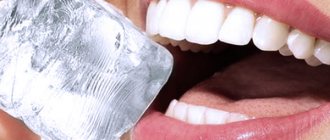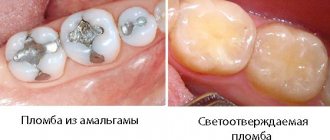Depulpation is the removal of the dental nerve. This is a rather complicated operation. Moderate pain that bothers the patient after surgery is quite expected and is perceived as normal. The nerve has been removed, which means there is nothing to hurt there. Most often, the discomfort felt is associated with damage to the healthy tissues surrounding the tooth. Such “normal” pain goes away within a few days after the procedure. To alleviate the condition and relieve discomfort, the dentist prescribes painkillers.
If the pain is acute (especially shooting) or does not go away within 5-7 days after depulpation, then this is already an alarm bell. In such situations, you should immediately consult a doctor. Patients most often note that pain occurs when pressing on the tooth, when touching it (including with the tongue), when eating, or when exposed to heat or cold. It can also appear at night without any provoking situations. You shouldn’t endure such pain and put off visiting a dentist.
Pain after filling
Most often, pain appears after removing the nerve and filling the canal. The reasons are usually poor-quality filling of cavities, allergic reactions to materials used for treatment, or microtrauma to tissues. The patient may experience the following symptoms:
- the tooth is sensitive to hot, cold food, touch;
- when closing the jaws, chewing, discomfort is felt;
- sharp, twitching pain develops at night and in the evening;
- eating becomes difficult.
General health worsens, headaches, tissue inflammation, and swelling of the cheek appear. If this condition lasts more than a week, you should urgently consult a doctor for treatment.
What is vital depulpation?
Vital pulpotomy is the amputation of an inflamed nerve under the influence of anesthetic substances. Treatment is carried out in one visit to the dentist. It consists of the following stages:
- anesthesia;
- removal of tooth enamel and dentin with a drill;
- antiseptic treatment of the mouth;
- removal of tissue (fibrous substance, neurovascular bundle) from the pulp cavity and canals;
- filling channels with a composite composition;
- closing the tooth cavity with restoration materials.
Incorrectly performed treatment
Poor quality materials and violation of treatment technology also cause pain. Reasons for such complications include:
- the channels are not completely cleaned;
- the nerve was partially removed;
- cavities remain under the filling material, leading to tissue destruction and the development of inflammatory processes;
- During filling, the material is moved beyond the apex of the root canal;
- The doctor did not notice any branches or lateral additional channels during treatment.
Should I take a painkiller or see a doctor?
All kinds of analgesics, as well as folk remedies, have a temporary effect. Pain is a kind of warning system about existing problems. If you do not pay attention to them, drowning them out with painkillers, minor defects will inevitably turn into serious diseases. If previously pulpless teeth that caused discomfort were removed, today they can be treated. Remaining pulp and even fragments of dental instruments can be removed. To do this, the doctor removes the filling material and cleans the canal. Repeated pulp removal in most cases allows you to completely get rid of negative manifestations.
The gum area can also be treated, involving medication, therapeutic or even surgical treatment. Sometimes, to eliminate the pain, it is necessary to treat the adjacent tooth. A person, based on his own feelings, cannot 100% correctly determine the source of inflammation, especially if the roots are located close to each other. We may mistakenly think about problems with one tooth when another needs help.
Contacting our clinic will allow you to accurately identify the defect in the shortest possible time. Diagnosis is carried out on the basis of tests, visual examination and examination of x-rays. Modern equipment makes it possible to repeat depulpation without causing harm to the patient’s hard and soft tissues. To confirm the quality of cleaning of the canals, as well as their filling, a repeated x-ray examination is carried out.
Other reasons
Other reasons that can cause severe pain after nerve removal include:
- allergic reactions to the use of materials during treatment, in addition to pain, itching, swelling;
- tissue injury, gum damage (accompanied by inflammatory processes, swelling, pain);
- neuralgia (damage to the trigeminal nerve during treatment can cause sharp, severe pain).
How to eliminate pain after depulpation?
Doctors recommend a number of preventive measures that can help prevent the development of discomfort after nerve removal:
- immediately after depulpation, you should follow the doctor’s advice, do not remove the cotton swab in the first twenty minutes;
- the first day you should refrain from solid, cold or hot food, smoking;
- The mouth should be rinsed at the frequency specified by the doctor; during the first days, do not disturb the sore area with a brush while brushing your teeth;
- for three days, rinse your mouth with neutral antiseptic agents at least twice a day.
Doctor's recommendations
To prevent complications and pain, the patient must adhere to the doctor’s recommendations. On the first day after treatment, you should rinse your mouth with a soda solution with the addition of a small amount of iodine. You can alleviate the condition by taking painkillers and avoiding eating solid food, hot or cold, on the first day. It is also recommended to refrain from physical activity.
You can alleviate the condition using the following methods:
- Propolis. To eliminate pain, you need to apply a small piece of propolis to the painful area, the discomfort quickly passes, the product has a disinfecting, anti-inflammatory effect.
- Vodka or cognac. If there is sharp, ongoing pain after removal, you can use rinses with cognac or regular vodka. The pain goes away quickly, alcohol has a disinfecting effect, eliminating infection of the diseased area.
- Rinse with vegetable oil. This remedy calms and alleviates the condition. You need to hold a small amount of the product in your mouth; you should spit out the oil after it turns whitish.
- Salo. You can relieve pain by applying it to the wound after removing the nerve.
- Ice compresses. An effective way to relieve pain and swelling is a crushed ice compress. You can make such compresses yourself or buy special ones at the pharmacy. They are applied to the cheek opposite the painful area. Instead of compresses, you can use an ice cube, holding it near the painful tooth.
When is it necessary to see a doctor?
After nerve removal, the patient should monitor the condition of the tissue. If the pain does not go away, you should consult a doctor who will conduct an examination and prescribe treatment. Also, contacting the clinic is required in the following cases:
- tissue swelling develops, which does not go away and intensifies over time;
- the throat feels sore, chewing and swallowing are difficult;
- purulent discharge appears;
- an unpleasant odor appears from the mouth.
Self-treatment in this case will only worsen the situation. If you do not consult a doctor, complications are likely to develop, including granulomas, cysts, and other dangerous diseases.
Factors causing pain
Unpleasant sensations while eating within 1-3 days after depulpation are not considered abnormal. This is due to inflammatory reactions resulting from therapeutic intervention. If the pain does not go away after a few days, you should definitely contact the clinic. Perhaps the pulp was not completely removed or the canals were not properly closed. Discomfort can be caused by filling material, which causes allergic reactions in the body. Individual intolerance more often than others becomes the cause of negative manifestations.
The consequences of improper pulp removal can appear at any time, especially when eating solid food. What to do if the pain occurs after a month or a year? An incompletely removed nerve, as well as the presence of voids in the canal, can periodically cause a feeling of discomfort. Also, one should not exclude cases of inflammation of neighboring tissues, forcing a person to think about the resumption of old problems. In rare cases, a pulpless tooth hurts when biting due to the presence of elements of a dental instrument. This can happen when working with narrow channels of complex shape. The smallest fragments, which, due to the limited visibility of the doctor, remain in the cavity, eventually cause a process of rejection.
What can cause hyperesthesia?
Caries
Focal demineralization of enamel and destruction of tooth tissue leads to the formation of a cavity in dentin. This, in turn, opens access to external irritants directly into the hypersensitive pulp. If treatment is not started in time, the process naturally leads to periodontitis, pulpitis and ends in tooth loss.
Thinning enamel
Intensive loss of enamel due to its rapid abrasion leads to exposure of dentin and a painful reaction of the tooth to any external influences. There are many reasons for enamel depletion: malocclusion, bruxism, fluorosis, incorrectly selected dentures, tooth loss, leading to increased stress on the remaining dentition. Among the pathologies that thin the enamel, there may also be pathologies not directly related to the condition of the teeth. These are, for example, hormonal disorders.
Cracks in enamel
Even microcracks and microchips in tooth enamel can lead to the development of a painful reaction to cold and hot. The cracks make it easier for external irritants to access the pulp.
Wedge-shaped defect
Like the previous reason, a wedge-shaped defect refers to non-carious pathologies of hard tooth tissue. It is characterized by the formation of a wedge-shaped lesion in the area of the tooth neck. Most often, pathology occurs on the front teeth. Its causes are periodontitis, damage to the enamel by external factors (for example, the wrong toothbrush, toothpicks, etc.), and inadequate oral hygiene. A wedge-shaped defect is the most vulnerable place in tooth enamel and dentin, facilitating access to the pulp by external factors.
Erosion of tooth enamel
The next non-carious lesion is erosion of tooth enamel and, sometimes, dentin. The definitive cause of this pathology is not clear. There are versions about its mechanical origin or development due to hormonal and metabolic disorders.
Hypoplasia
Sometimes the cause of dental hypersensitivity is underdevelopment of the tissues or the entire tooth during its formation. This pathology is irreversible and leads to many problems, of which hypersensitivity is not the most unpleasant. As a rule, treatment consists of filling the affected tooth or placing it under a crown in order to eliminate the effects of external factors on the tissue.
Necrosis
Hard tooth tissues can undergo necrosis due to a variety of reasons - from disturbances in the functioning of the central nervous system to exposure to acids and alkalis. Dead enamel does not protect the tooth well, which leads to pain and temperature reactions.
Periodontal pathologies
Any inflammation of the periodontal tissues (periodontal) also leads to painful manifestations and threatens tooth loss. In addition, the periodontium is a tissue rich in nerve endings, and excessive exposure to it is in itself unpleasant.
Other reasons
Other causes of enamel damage include a variety of external factors. These include:
- some dental procedures, including dentures, whitening, fillings and nerve removal,
- improper care with unsuitable devices and hygienic compositions,
- deficiency of minerals and vitamins in the body: calcium, fluorine, vitamins C and D, magnesium. The lack of active substances provokes the destruction of enamel. This is especially true for children, the elderly and pregnant women.
Sign up for installation of dental inlays at a discount:
What is a tooth core?
Stump inlays are structures that enter one third of the tooth canal, restoring the lost part of the tooth from above. A crown is installed on top of the stump inlay, which is made from the material chosen by the patient.
Often there are teeth restored with “extended” fillings on pins. It should be noted here that some dentists install huge fillings on their patients’ posts instead of crowns. Such fillings do not last very long, and they fall out even if you do not chew anything hard. As a result of chewing, this huge filling, together with the pin, goes sideways and breaks the root of the tooth in which the pin was installed. Such a root usually has to be removed. In rare cases, it is possible to install a crown on a broken tooth. This usually happens in cases where the crack is not below the level of the gum.
How long have dental inlays been used on the Russian dental market?
Quite a long time ago, more than 10 years. It’s just that not all patients agree to visit the doctor several times. They want to do everything in one day, so they choose large fillings, fillings on pins (“extended”). Some doctors make concessions to such patients and do as the patients want, but this is wrong. A healed tooth with a large filling will simply chip quickly, and there is a chance of losing the tooth altogether, so it is better to put an inlay on it.
How many tabs have you installed as a specialist?
Hard to say. I've been working with tabs for about five years. We install 10-15 tabs per month. There are patients who need to install several inlays at once, for example, due to increased tooth wear.
Let's summarize our conversation. What is better - an inlay, a crown or a filling?
Everything is done according to indications, but, of course, a ceramic dental inlay is best.
Let me give you an example: I had patients who had a ceramic inlay installed on one side and a metal-ceramic crown on the other. And according to reviews, the inlay is much better, since most often food gets under metal-ceramic crowns and accumulates under them. This may cause an unpleasant odor.
If metal-ceramic crowns were installed, the metal edge may be exposed, which does not add aesthetics.
Patients also do not like large fillings, which shrink after a certain time, and there is a high probability of chipping the tooth wall or caries.
In these cases, tabs are the best option.
Doctor, thank you for the detailed story!
How are teeth treated under a crown?
An example is the inflammatory process in the apical (deepest) part of the root canal. In case of poor preparation, the canal may not be sealed to its full depth, which leads to the development of infection. To avoid removing the crown, resection of the apical part of the root is performed. The procedure is performed by a dental surgeon and takes from 30 to 60 minutes.
The doctor drills a small hole in the bone tissue. Through it, he cuts off the poorly sealed tip from the root and removes the purulent sac. It should be noted that this method is characterized by minimal trauma. In addition, the procedure is performed under anesthesia, so the patient does not experience pain or discomfort. After removing a section of the root, the remaining part is carefully “sealed” with a special material for further isolation from microbes.
It is important to understand that it is not always possible to do without crown removal. The final decision on the method of treatment is made by the doctor, who may prescribe an X-ray examination to clarify the cause of inflammation. This is due to the fact that additional root canals or suspected cracks require mandatory removal of the structure.
What ways to get rid of toothache are there?
- Let's start with the fact that if you are experiencing severe throbbing pain, you should not endure the pain. The dentist will conduct a detailed diagnosis and be able to identify the cause; it could be damage to soft tissues or incompletely cleaned canals. Next, you will be prescribed effective treatment.
- Under no circumstances should you search the Internet for methods to relieve pain at home and self-medicate. You need to identify the exact cause and undergo treatment. Otherwise, the disease will progress and inflammatory processes will spread to neighboring teeth.
- If, in addition to pain, you experience any other unpleasant symptoms, for example, severe swelling, discharge, fever, etc., you should also consult a doctor immediately.











